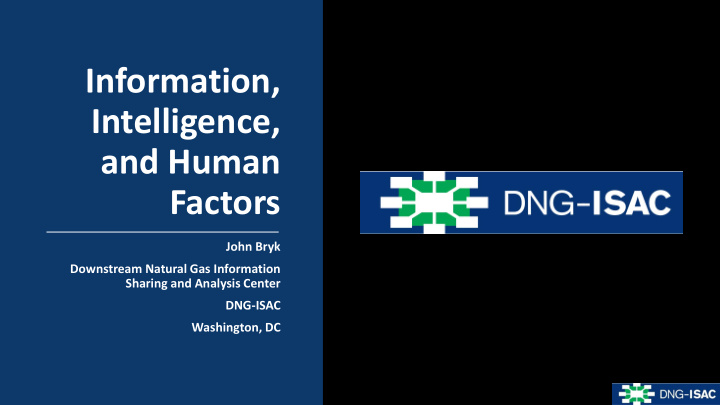



Information, Intelligence, and Human Factors John Bryk Downstream Natural Gas Information Sharing and Analysis Center DNG-ISAC Washington, DC
Information Sharing and Analysis Center (ISAC) • John Bryk, Cyber and Physical Threat Intelligence Analyst at the Downstream Natural Gas Information Sharing and Analysis Center (DNG-ISAC) • DNG-ISAC serves natural gas utility (distribution) and pipeline (transmission) companies • Coordinates closely with the electric industry (E-ISAC) • Promptly disseminates threat information and indicators • Administered by the American Gas Association (AGA) in partnership with the Interstate Natural Gas Association of America (INGAA) and Canadian Gas Association (CGA)
Key points • Threat data, information, and intelligence are all very different • In the progression from data to information to intelligence, the volume of outputs reduces while the value of those outputs increases • Computers can’t produce threat intelligence while humans aren’t suited for collecting and processing large volumes of threat data • Action must always be the end goal
Data information intelligence
Data • Fact without meaning; meaning must be assigned • Individual elements that when put together create contextual information
Human speed v. computer speed 140 4000 words per minute in events per second Morse code
Information • Pieces of data that have been collected • Produced when a series of points are combined to answer a simple question • Easily shared within the industry • Sometimes shared with government
Volume v. value 1,000,000,000 10,000 threat platform data events indicators
Human factors - volume v. value 1 actionable 10,000 threat platform intelligence report indicators
Intelligence • Magic Formulas: • Information + Analysis = Intelligence • Requirements + Intelligence = Action • U.S. Department of Defense defines intelligence as: The product resulting from the collection, processing, evaluation, analysis, and interpretation of available information concerning hostile or potentially hostile elements or areas of actual or potential operations
Human factors - requirements • Only humans can determine what actions should be taken and why • Creating good requirements is a uniquely human function • Good requirements: • Ask only one question • Focus on a specific fact, event, or activity • Provide intelligence required to support a single decision • Are tied to key decisions that have to be made • Supply the latest time the information is of value (LTIOV)
Validating requirements • Only humans can determine what actions should be taken and why • Necessity • Feasibility • Specificity • Timeliness
Intelligence challenges • Incomplete threat landscape understanding and qualified workforce shortage • Collection bias in U.S. Intelligence Community and information security community • Reacting to threat du jour instead of following a structured intelligence cycle
Key takeaways • Threat data, information, and intelligence are all very different • In the progression from data to information to intelligence, the volume of outputs reduces while the value of those outputs increases • Threat intelligence platforms produce data and information which human analysts can use to produce and share actionable (operational) threat intelligence • Computers can’t produce threat intelligence while humans aren’t suited for collecting and processing huge volumes of threat data • Action must always be the end goal
Key takeaways The entire presentation boiled down to two points: • Information and intelligence are not the same thing • Intelligence must be actionable
Questions? John Bryk DNG-ISAC Cyber and Physical Threat Analyst American Gas Association jbryk@dngisac.com
Recommend
More recommend